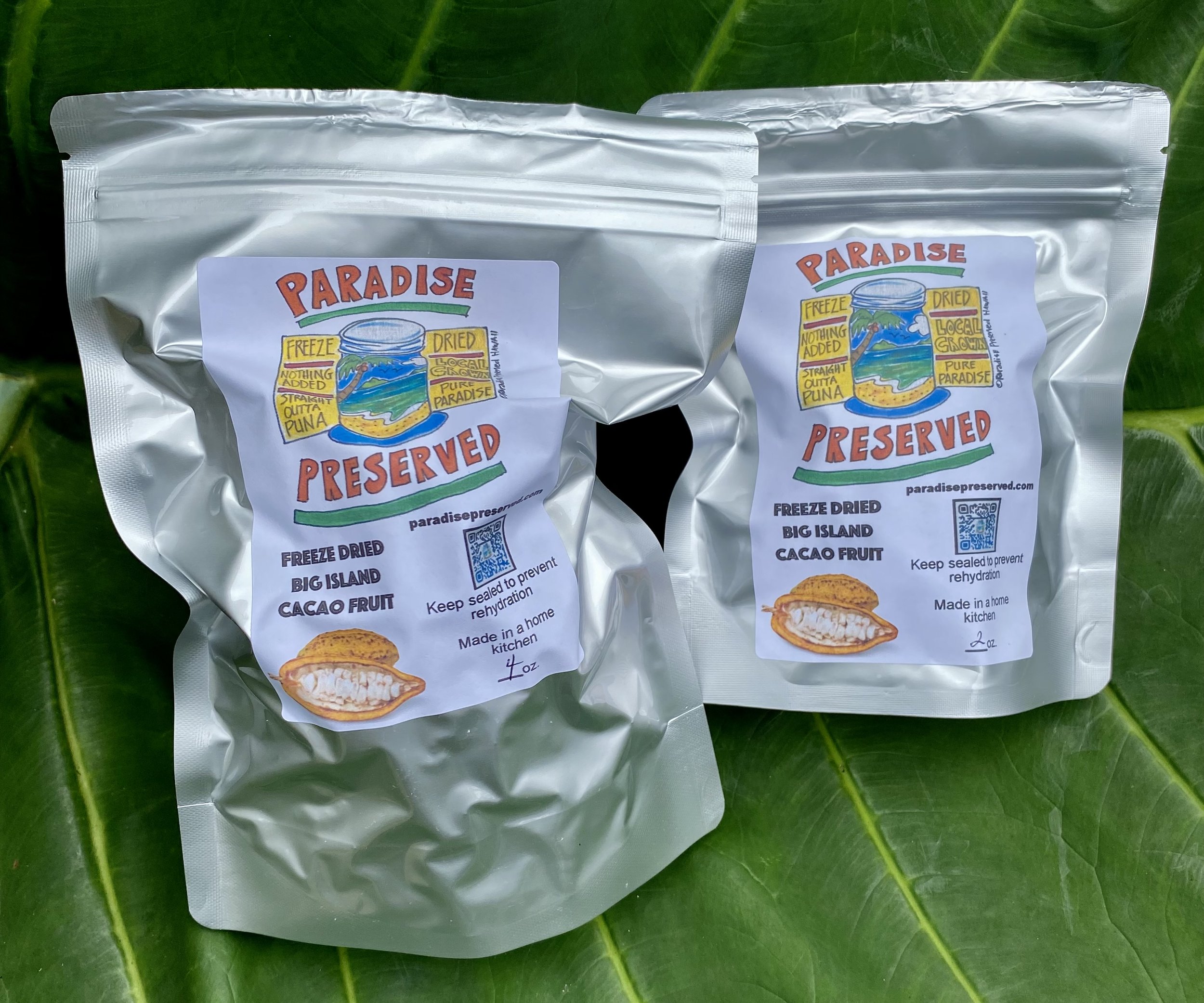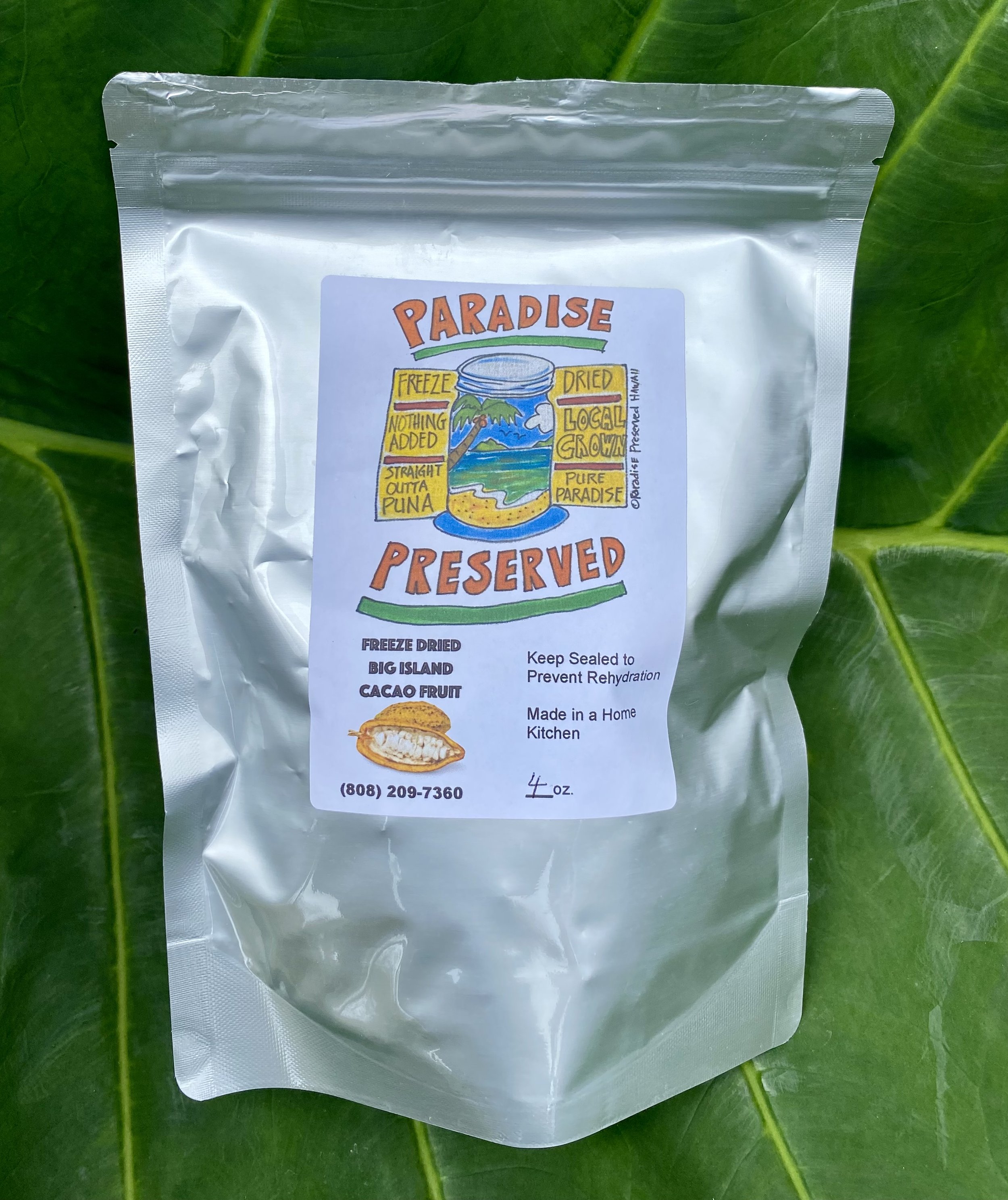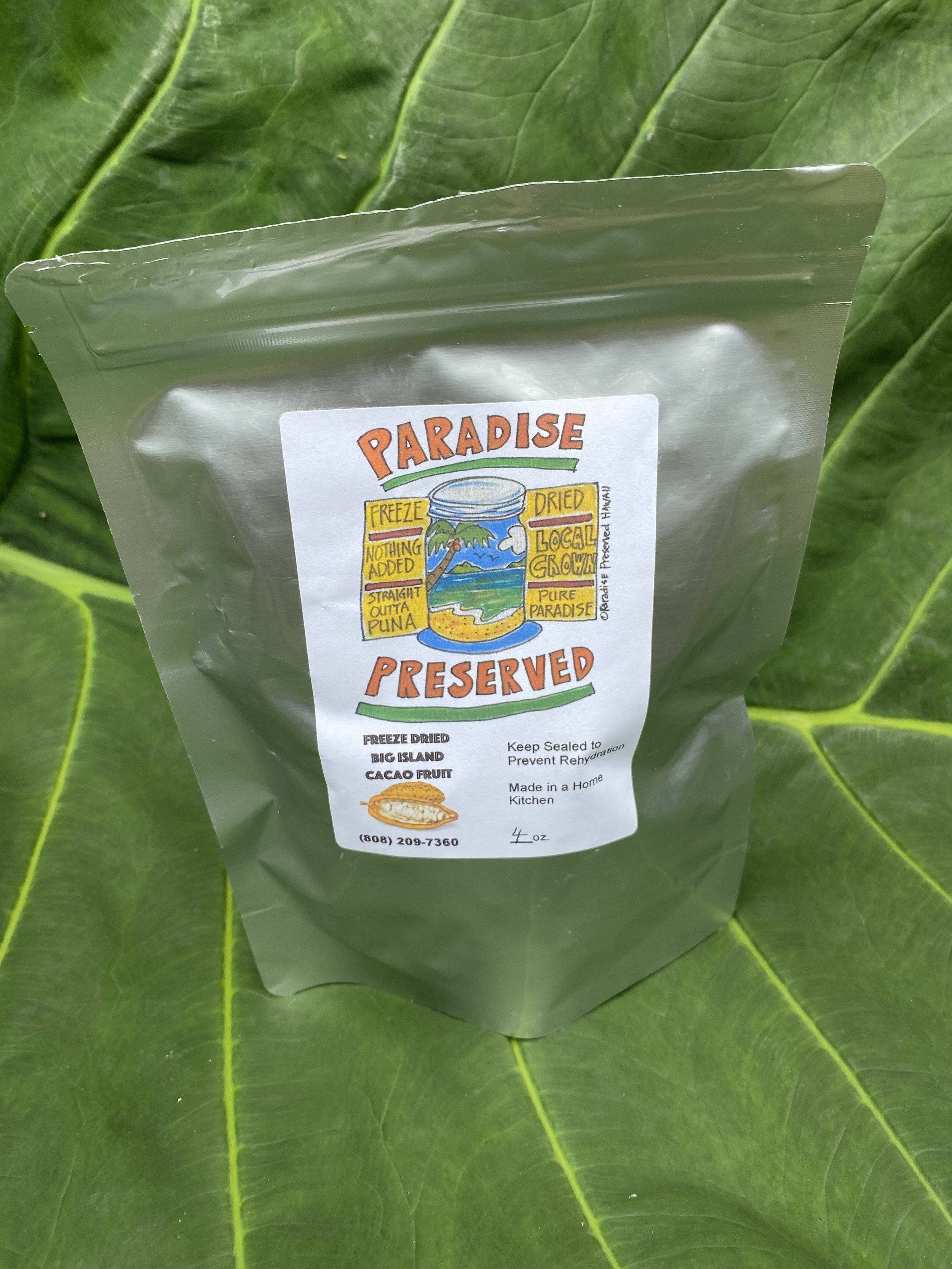 Image 1 of 4
Image 1 of 4

 Image 2 of 4
Image 2 of 4

 Image 3 of 4
Image 3 of 4

 Image 4 of 4
Image 4 of 4





Freeze Dried Cacao Fruit Pulp
🍫 What Is Cacao Fruit Pulp?
When you crack open a cacao pod, you'll find cacao beans surrounded by a soft, sticky, white pulp.
This pulp is tropical, tangy, and sweet—flavor notes often include lychee, mango, pineapple, and citrus.
It’s not chocolatey—that's the beans’ job—but it's an entirely different kind of delicious.
❄️ What Does Freeze-Drying Do?
Freeze drying removes moisture while preserving the fruit’s natural flavor, enzymes, and nutrients.
The result is a powder or crunchy bits that are shelf-stable and packed with the original flavor.
Unlike sun drying or heating, freeze-drying doesn’t cook or alter the taste or nutrition much.
🌿 Nutritional & Functional Perks
Natural Sweetener
It has a low glycemic index and can be used as a fruit-based sweetener in smoothies, bars, or baking.Rich in Antioxidants
Just like the cacao bean, the pulp contains polyphenols and other antioxidants.Prebiotic Fiber
It contains dietary fiber that can support gut health and digestion.Vitamins & Minerals
Particularly good for vitamin C, potassium, magnesium, and phosphorus.
💡 How It’s Used
Smoothies: Add powder or small chunks for a sweet, tropical twist.
Bars & Bites: Often used in raw cacao energy bites or protein bars.
Baking: Great for natural sweetness and fruity undertones in cookies or cakes.
Yogurt, Granola, or Ice Cream toppings.
Fermented Drinks: In fresh form, cacao pulp is sometimes used for juices or kombucha-like drinks (think "Cacao Nectar").
🌎 Why It Matters
Using cacao fruit pulp helps reduce waste in cacao production. Normally, only the beans are used and the pulp is discarded.
It supports more sustainable cacao farming by giving farmers another product to sell from the same crop.
🍫 What Is Cacao Fruit Pulp?
When you crack open a cacao pod, you'll find cacao beans surrounded by a soft, sticky, white pulp.
This pulp is tropical, tangy, and sweet—flavor notes often include lychee, mango, pineapple, and citrus.
It’s not chocolatey—that's the beans’ job—but it's an entirely different kind of delicious.
❄️ What Does Freeze-Drying Do?
Freeze drying removes moisture while preserving the fruit’s natural flavor, enzymes, and nutrients.
The result is a powder or crunchy bits that are shelf-stable and packed with the original flavor.
Unlike sun drying or heating, freeze-drying doesn’t cook or alter the taste or nutrition much.
🌿 Nutritional & Functional Perks
Natural Sweetener
It has a low glycemic index and can be used as a fruit-based sweetener in smoothies, bars, or baking.Rich in Antioxidants
Just like the cacao bean, the pulp contains polyphenols and other antioxidants.Prebiotic Fiber
It contains dietary fiber that can support gut health and digestion.Vitamins & Minerals
Particularly good for vitamin C, potassium, magnesium, and phosphorus.
💡 How It’s Used
Smoothies: Add powder or small chunks for a sweet, tropical twist.
Bars & Bites: Often used in raw cacao energy bites or protein bars.
Baking: Great for natural sweetness and fruity undertones in cookies or cakes.
Yogurt, Granola, or Ice Cream toppings.
Fermented Drinks: In fresh form, cacao pulp is sometimes used for juices or kombucha-like drinks (think "Cacao Nectar").
🌎 Why It Matters
Using cacao fruit pulp helps reduce waste in cacao production. Normally, only the beans are used and the pulp is discarded.
It supports more sustainable cacao farming by giving farmers another product to sell from the same crop.
🍫 What Is Cacao Fruit Pulp?
When you crack open a cacao pod, you'll find cacao beans surrounded by a soft, sticky, white pulp.
This pulp is tropical, tangy, and sweet—flavor notes often include lychee, mango, pineapple, and citrus.
It’s not chocolatey—that's the beans’ job—but it's an entirely different kind of delicious.
❄️ What Does Freeze-Drying Do?
Freeze drying removes moisture while preserving the fruit’s natural flavor, enzymes, and nutrients.
The result is a powder or crunchy bits that are shelf-stable and packed with the original flavor.
Unlike sun drying or heating, freeze-drying doesn’t cook or alter the taste or nutrition much.
🌿 Nutritional & Functional Perks
Natural Sweetener
It has a low glycemic index and can be used as a fruit-based sweetener in smoothies, bars, or baking.Rich in Antioxidants
Just like the cacao bean, the pulp contains polyphenols and other antioxidants.Prebiotic Fiber
It contains dietary fiber that can support gut health and digestion.Vitamins & Minerals
Particularly good for vitamin C, potassium, magnesium, and phosphorus.
💡 How It’s Used
Smoothies: Add powder or small chunks for a sweet, tropical twist.
Bars & Bites: Often used in raw cacao energy bites or protein bars.
Baking: Great for natural sweetness and fruity undertones in cookies or cakes.
Yogurt, Granola, or Ice Cream toppings.
Fermented Drinks: In fresh form, cacao pulp is sometimes used for juices or kombucha-like drinks (think "Cacao Nectar").
🌎 Why It Matters
Using cacao fruit pulp helps reduce waste in cacao production. Normally, only the beans are used and the pulp is discarded.
It supports more sustainable cacao farming by giving farmers another product to sell from the same crop.
